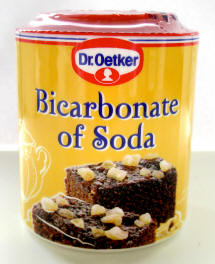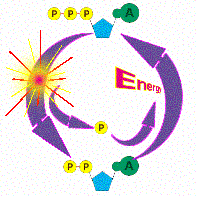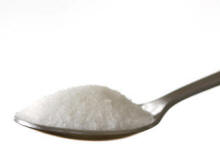Supplements ~ Sodium Bicarbonate
 Sodium Bicarbonate,
Bicarbonate of Soda, or plain old Baking Soda, to our mums, is
potentially one of the best value for money ergogenic aids on the
market. It's cheap, it's plentiful, it's legal and it works.
Sodium Bicarbonate,
Bicarbonate of Soda, or plain old Baking Soda, to our mums, is
potentially one of the best value for money ergogenic aids on the
market. It's cheap, it's plentiful, it's legal and it works.
Read on to see if it's for you.
What is it?
Sodium Bicarbonate is basically an alkalising agent that
reduces, or buffers to use the correct term, the acidity of your
blood.
If you've read our Lactate factsheets, you'll know why this is important.
What does it do?
During intense
anaerobic exercise, a process called metabolic acidosis occurs. You
know this is happening when your legs start to hurt and you feel the
dreaded burn.
Physiologically speaking, your blood ph begins to drop and you begin to suffer from reduced performance and increased fatigue. Neither of which on their own is good; when they happen at the same time it's bad, very bad.
Sodium Bicarbonate is good because it:
▼ deposits itself in the blood to alkalise the acid
▼ facilitates lactate dissipation
▼ increases glycotic energy production
▼ delays decreased muscle contractile force
▼ can increase overall plasma volume
▼ increases blood concentrations of bicarbonate
How
does it do it?
When exercising intensively
we use the anaerobic glycotic energy system and the lactic system.
Check out the
Anaerobic Capacity factsheet for a detailed description.

It's the presence of the hydrogen ion that makes the muscles acidic, which slows down enzyme activity, which prevents glucose breakdown, which stops energy being produced, which slows you down, which (as if you didn't know) isn't good.
When you sprint for the line and die 20 yards before it, that's when what I've just described has happened to you.
As an aside, acidic muscles increase irritation of the nerve endings which is why we feel pain and burn. This is where the magic of Sodium Bicarbonate comes in.
So, to recap, glycolysis generates hydrogen ions and pyruvic acid in the working muscles. This makes the muscular cells acidic, which interferes with their power producing capabilities.
The good old mitochondria we took all winter to carefully nurture and build up are now being used to sweep up acid from the muscles and take it to in to the blood stream. Not their primary purpose; which means they can't be used to make us go faster.
Again, without getting too technical; Sodium Bicarbonate can't penetrate the muscle itself, it has to wait for the acid to come to where it's stalking; in the blood stream.
 When the "acid carrying
mitochondria" enter the blood stream from the muscle, the acid is
"introduced" to the Sodium Bicarbonate.
When the "acid carrying
mitochondria" enter the blood stream from the muscle, the acid is
"introduced" to the Sodium Bicarbonate.
Now the alkalising properties can neutralise the acid and allow the "clean" mitochondria to be freed up to dive back in to the muscles to get another payload of acid. Thereby speeding up the lactate flushing process.
That's why it's so important to develop your mitochondria during your winter base mileage because that's when you develop the capabilities to help you go super fast in the summer.
No slow riding early on, no fast riding when you need it most.
How
can it help me?
As we've seen, intense,
short-burst, energy production increases the acidity inside the
muscle cells to a point at which they quickly become overwhelmed.
Very soon after, the same happens to your blood.
If we could speedily process acidity regulation within the muscle cells and delay this fatigue cycle, we could exercise intensely for longer.
Sodium Bicarbonate supplementation allows the acid produced within the muscle cells to be processed when it enters the bloodstream, thus more quickly reducing the level of acidity within the muscle cells themselves.
The normal pH of the muscle cell is 7.1. If, due to intense exercise, metabolic acidosis takes place, the build up of acidity continues and pH is reduced to around 6.5.
It's around this point that muscle contraction is impaired and the low pH stimulates the free nerve endings in the muscle resulting in the perception of burning pain!
This point is (often incorrectly) referred to as the lactic threshold or anaerobic threshold. Neither point actually exists (as a threshold anyway) and both incorrect terms actually refer to differing points on the physiological continuum.
But they've fallen in to common use over the years and have become what most people recognise as the point of pain that arrives quickly, hurts your legs and makes you slower.
The correct term, which describes exactly what is happening, is the onset of blood lactate accumulation (OBLA).
If you've done one of our wVO2max or RAMP Tests, or even a 30 second SMInt effort, you'll know exactly what I mean and how it feels.
Sodium Bicarbonate supplementation can help keep blood pH low, thereby allowing the mitochondria to drag more hydrogen ions, more quickly from the muscle allowing more intervals or longer duration to the onset of fatigue. All in all a good thing.
 What is the
dosage required?
What is the
dosage required?
The acute dosage that's
found to be particularly effective is 0.3g per kilogram of bodyweight.
Taken an hour before training or competition.
More isn't necessarily better, as the risk of gastric distress, and a lost workout, increases significantly as dosage heads towards 0.5g per kilogram.
So don't do it!
However, you could "chronically load" by taking 0.5g per kilogram of bodyweight, divided in to four doses a day for five days, leading up to the event.
One way to ease acute dosage ingestion is to mix the powder into a pint of water and sip it over thirty minutes to an hour before intense exercise.
Sodium Bicarbonate takes around sixty to ninety minutes to kick in. So obviously you need to take it in adequate time to coincide with your expected high intensity muscle contractions.
Experiment with lead times and dosages to make sure you get it right. What works for your mate won't necessarily work for you.
What
should I be aware of?
To put it politely, gastric distress, nausea and or bloating.
Whatever it is, it isn't nice and anyway you should always test out any supplementation in recovery weeks.
Never, ever, ever try a new supplement or ergogenic aid on the morning of a key race. Ever. I've seen it done more times than you would imagine, normally with a new, previously untried energy drink. It's never good and it normally means there's one less person to beat!
Stick to the dosage recommended and build up to it over two or three test sessions at differing intensities. What works on the way home from work might not necessarily work when screaming in a ten mile time-trial!
Take
Note:
This article is neither an endorsement or a condemnation of the
subject of this article or any other supplement use. It is
here to allow the reader to draw their own informed conclusion.
Do your research and if any doubt consult a physician before undertaking any supplement regimen. Never take more than the stated dose and never mix any drug or supplement with alcohol. Always check that you are not contravening any sporting code, ethics or permitted levels for your sport before undertaking any supplementation.
Where
can I get some?
Don't be duped by "pure" stuff from body building suppliers!
Any corner shop, supermarket or backing market stall should have
some.








